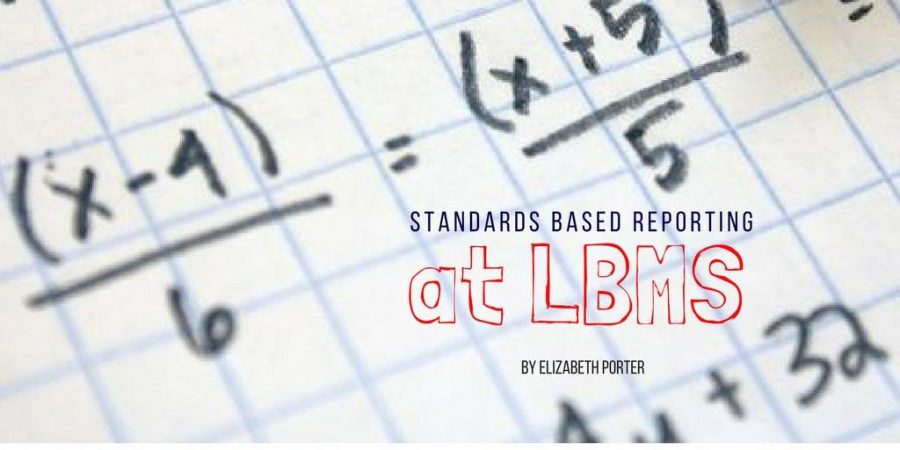If you’re like me, you might remember getting a report card or progress report that read something like this in middle school:
Math 8: A-
Elizabeth contributes well to class discussions. She should try to be more consistent in turning in her homework. She is a pleasure to have in class.
Does that–or some version of it–sound familiar? Your parents look at that summary and think “Oh, good, she got an A” and make a mental note to get on you about your homework. Then, at parent-teacher conferences, your parents and teacher discuss how you contributed to class discussions and what you could do to be more consistent about homework.
Lake Bluff Middle School –my middle school– is making changes to improve the quality of the feedback students and parents receive on their progress reports and in PowerSchool. LBMS is moving from traditional letter grades, A, A-, B+, B, B-, C etc. to a system called “Standards Based Reporting.” Under the SBR system, that same student might get the following information on his progress report:


This change, intended to enhance feedback and improve learning, is being met with resistance from concerned parents. Some are expressing doubts about the desirability of the new system, the method by which it was communicated, and the impact it might have on their kids’ motivation to learn, and their ultimate preparation for high school. In short, it is change. And change, as we have come to know in recent years, can be scary. After all, the old system worked for them–why shouldn’t it work for their kids? While Lake Bluff Middle School has been shifting away from traditional letter grades and towards Standards Based Reporting (SBR) for a while now, it still feels, to some parents, like a sudden, radical, change.
Before condemning or applauding SBR, one must first understand what exactly it is. I talked to LBMS Principal Nate Blackmer and District 65 Curriculum Coordinator/Teacher Leader Kellie Bae, who explained that Standards Based Reporting is a method of reporting to parents and children the fundamental concepts a child is working on, which concepts the child is expected to understand at the end of the course of study, and how far that child has progressed toward that standard at the particular point in time. So, while the actual curriculum and classroom experience will not be changing significantly, the way in which teachers report on student achievement will. In practice, the adoption of SBR at LBMS means that progress reports will feature several “grades” for any given class. For example, in math class a student will be assessed on a scale of 1-4 on a variety of individual math skills that they have been taught in class throughout the grading period. Then, a separate set of behavioral standards, called “learner characteristics” accompany the subject learning standards. So SBR takes that one letter grade, A, B, C, and breaks it down into its component parts. The standards themselves are no different than have been used at LBMS and elsewhere, but what is changing is the way the child’s progress on those standards is being reported to the child and his/her parents.
The basic philosophy behind SBR is multifaceted: encourage students to take ownership of their education and push themselves, and allow teachers to communicate more effectively and accurately with parents and students. Instead of grading a student based on average points earned on cumulative tests, they are assessed based on the level of mastery they have shown for each standard. The goal of the LBMS teachers and administration is simple: change the focus of education from accumulating a certain number of points that corresponds to an “A” to gaining mastery of the topics taught, to the best of each individual student’s ability. Principal Blackmer explained, “SBR is changing how we talk to kids. It used to be ‘how do I get 90% in this class?’ Now it’s ‘Ive noticed my accuracy with two-step equations is lower than I’d like it to be, how can I get it up to a 3 or 4?’
Research about SBR at LBMS began two years ago and at this point the school is using a hybrid model between traditional grading and SBR. This means that this year students received traditional letter grades on their progress reports. However, in class they were using many of the concepts incorporated in SBR. In fact, a majority of the educational tools integral to SBR have been used at LBMS and schools around the country for years, including rubrics, reflections, feedback, and the subject specific learning standards referred to as the Common Core. All of these concepts are aligned with the goal of SBR, making the shift not as radical as it may seem. Another important thing to consider is that LBMS is far from the first school to implement SBR. Recently, District 103 elementary schools (which feed into Stevenson) began to use SBR for grades K-5 and plan to extend SBR to grades K-8 by 2018-2019.
Another understandable concern for middle school parents is the transition to high school and preparation for college. We’ve all been there. It can be rough. Still, the LBMS and LFHS administrators both believe that going into high school from a school that uses SBR does not put students at a disadvantage. As for placement into high school classes, the more specific breakdown in evaluation provides high school teachers with much more information about their new students’ strengths and weaknesses. Consider this: if a teacher sees that a student received an A in Language Arts they can only infer that they are generally a good student. Different teachers grade classes more harshly or leniently and emphasize different skills, therefore a letter grade says very little about that student’s ability. On the other hand, if the same teacher saw that a student earned a “4” in reading comprehension, a “3” in grammar skills, a “2” in using evidence to support their claims in essays, etc. the teacher would have a much better idea of the abilities of the student making them more prepared to build on those skills and address weaknesses in the future. While making the transition to SBR, LBMS and LFHS teachers and administration have worked closely together. According to Mr. Blackmer, Lake Forest High School principal Dr. Chala Holland agreed with Mr. Blackmer that many of the philosophical components of LBMS’s new system are in line with the direction that LFHS has taken in pursuing the best possible education for all students. In fact, an increasing number of LFHS teachers are adopting versions of “gradeless classrooms”, a relative of SBR, in the upcoming school year.
Another component of SBR is allowing students to redo and retake many of their assessments. If a student did not meet some of the standards assessed on his math test, he has the opportunity to work with his teacher to improve those skills and then retake the assessment. One 8th grade student I talked to explained that the opportunity to retake assessments in accordance with SBR, “gives me a reason to not just move on when I fail, but figure out why I failed and try to fix it.” Principal Blackmer further explained the reasoning behind this, “If a student hasn’t demonstrated mastery of material, we don’t want to pass judgment and say ‘you didn’t learn this fast enough’ and give up on them. We want to reinforce that these concepts are important for them to learn because they are going to come up later.” Adopting this growth mindset will aid students in making the shift to more challenging high school courses where motivation to succeed has to be intrinsic and communication with teachers is supremely important.
SBR has been designed to benefit all students–from those who earn straight A’s to those who are more used to getting C’s. If you are an “A student,” standards allow you to see which areas you can improve on, and shows the teacher where they can provide you with more challenging problems. For less confident students, standards identify areas that are in need of improvement and take away some of the stress of rushing to keep up in class while falling further behind because each unit builds on the last. SBR is not “dumbing down” class material, if anything it is asking more from students. In terms of homework assignments, they will be factored into a separate assessment of the student than mastery of the material. If a student struggles with executive functioning or organization but participates in class and has mastered the content, their grade should reflect that mastery of the content and not be excessively decreased by lost homework assignments. At the same time, a student that turns in every homework assignment but does not understand the material should not have an artificially inflated grade because they may not take the time to learn the material, which will inevitably come back around. However, these learning habits are very important for student development, therefore there will be a section of the progress report dedicated to skills such as work habits, homework completion, attentiveness, and cooperation.
At the end of the day, SBR is new in theory, but at the same time it’s not. The goal of the LBMS administration is to provide teachers with a common means of assessing and reporting progress on a more granular level, while providing parents and children with additional insight into student learning. It helps ensure that school serves the needs of every child rather than the few who work at the predetermined pace of the teacher. Educators are learning that the study skills, work ethic and determination you develop in middle school is far more important than weather you earned an A or a B in any given class. In high school, grades are arguably more important, but middle school is a time to foster a desire to learn, become confidence in your abilities, and develop the determination to improve. If a child walked out of LBMS with those skills, they would be far more prepared for the rigor of high school and the “real world” than a child who breezed through only focused only acquiring points and earning all A’s but never learning what it truly means to be a good student. I am confident that parents who learn about and come to understand SBR will see its tremendous potential to benefit not only their communication with teachers, but their child’s education as well.
Change is hard, but the traditional grading system is not perfect, and as members of this community, we have a duty to work with our educators, move beyond our comfort zone, and improve upon it. Even if it means not getting reports like “Elizabeth is a pleasure to have in class.” Students are more than a one sentence compliment. The feedback we receive should reflect that.













--=== • Sep 13, 2017 at 1:37 pm
Old grade scale better, since it mimics high school grading scale better. therefore, preparing people better for high school.